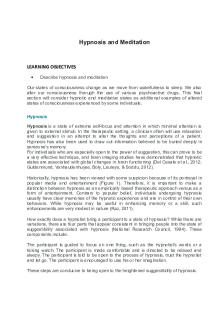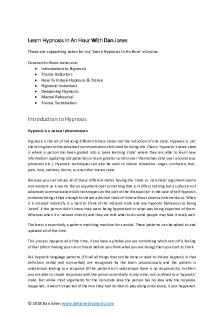Tutorial Hypnosis PDF

| Title | Tutorial Hypnosis |
|---|---|
| Course | Delusions and Disorders of the Mind and Brain |
| Institution | Macquarie University |
| Pages | 5 |
| File Size | 165.3 KB |
| File Type | |
| Total Downloads | 89 |
| Total Views | 172 |
Summary
tutorial...
Description
Welcome to our tutorial on Hypnosis. 1. What does hypnosis mean to you? If you have not had a chance to watch the hypnosis lectures yet, you might be wondering why we have a topic on hypnosis in a course on delusions and disorders of the mind and brain. It turns out, hypnosis has an excellent application related to delusions. However, before we get to that, I want you to pause and consider what you think of when you hear the words “hypnosis” or “hypnotised” Participation Question 1 Part A. Spend a couple of minutes writing down your current understanding of what hypnosis is and how it might feel to be hypnotised. Part B. Can you think of an example of hypnosis being represented in popular culture? If you have previous experience with hypnosis, you can share that too. If you have not had any personal experience with hypnosis in a research setting, then your current concept of hypnosis might be highly influenced by the ways in which hypnosis is presented in popular culture. There is actually quite a long history of hypnosis research by psychologists and medical practitioners with different ideas of hypnosis. Below is a list of historical psychologists and medical practitioners who had something to say about hypnosis. After each name is a highly simplified summary of their view of hypnosis. Please do not try to memorise this list. Rather, note: 1. the variety of views of hypnosis 2. As early as the 18th Century, Franz Mesmer was interested in hypnosis, and interest in hypnosis continues to the present day. 3. the view of hypnosis as a personality trait. We will come back to this later in the tutorial. Franz Mesmer (1734-1815): animal magnetism James Esdaile (1808-1859): hypnosis as anaesthetic Jean-Martin Charcot (1825-1893): hypnosis as hysteria Hippolyte Bernheim (1840-1919): hypnosis as suggestion Pierre Janet (1859-1947): hypnosis as dissociation Sigmund Freud (1858-1939): hypnosis as road to unconsciousness William James(1840-1910): hypnosis as multiple streams of consciousness Clark Hull (1884-1952): hypnosis as learned behaviour Hans Eysenck (1916-1997): hypnosis as personality trait
2. Misconceptions: Myths about hypnosis In section 1, you had a chance to think about your own view of hypnosis and were given an extremely brief and simplified history of research in hypnosis. Despite this relatively long research history, hypnosis is a complex phenomenon that is often misunderstood by the general public. Below are a couple of prominent myths about hypnosis. Did any of these come up in your description of hypnosis? Myth 1: You must be gullible if you can be hypnotised Fact: •
Almost everyone can be hypnotized to some degree. Hynotisability (the ability to be hypnotised) is a normally distributed trait that is unrelated to other personality traits. This means it follows a normal curve like the one
above. •
• •
10-15 % of the population are “high hypnotisable”, meaning that they will find most of the hypnotic suggestions used in research to be compelling and respond. A person’s fantasy proneness and level of absorption can indicate whether a person is more likely to be hypnotised. 10-15% of the population are “low hypnotisable” meaning they will experience almost nothing during a hypnosis session The majority of people (70-80%) fall somewhere in the middle, responding to a few hypnotic suggestions (more information on what a hypnotic suggestion is provided below)
Myth 2: You will not be able to resist hypnosis Fact: • People generally will not do things that go against their personal values or beliefs while they are hypnotised
• •
You are still aware of what is happening around you when you are hypnotised (ie, you are not unconscious!) It is up to you whether you accept or reject the hypnotist’s suggestions; you cannot be controlled by a hypnotist. People may only respond to some suggestions and not all if they do not wish to or do not feel compelled to do so.
Myth 3: A hypnotist can control your behaviour Fact: • Hypnotists do not have special powers! • You need to be willing to experience hypnosis in order to experience it • A positive attitude is necessary but not always sufficient • Not everyone can be hypnotised (Remember the 10-15% of the population that are low hynotisable.) • Responses in hypnosis depend on the capacities and abilities of the participant, not on special techniques of the hypnotist.
3. What is it like to be hypnotised? What does hypnosis feel like? •
• • • •
Most people describe hypnosis as: ― Relaxing ― Pleasant ― Easy to go along with ― Less dramatic than they expected A common feature of hypnosis is a reduced sense of agency. Participants often describe actions as occurring spontaneously and easily But participants consistently report feeling that they could have stopped at any time if they wanted to Studies of hypnotic compliance show that people will not do anything dangerous or against their values People can only do things in hypnosis that are also possible without hypnosis
What is a hypnotic suggestion? There are four key types of hypnotic suggestions A. Direct motor suggestions: These are suggestions to perform a motor action such as lowering your hand, or if you have your hands held together, a motor suggestion could be moving them apart. This type of hypnotic suggestion is usually considered the “easiest” and is the most likely to be compelling to individuals with medium levels of hypnotisability. B. Motor challenge: These are suggestions that invite the participant to challenge something they have been told. For example, if a participant is told that their fingers are tightly interlocked together, a motor challenge suggestion would invite them to try and
move their hands apart. These are also a form of motor suggestion but slightly more difficult than direct actions. C. Perceptual-cognitive suggestion: These hypnotic suggestions involve changing your cognitive state or perception of your environment. For example, a suggestion could be that a mosquito is buzzing around your head, or that you hear music playing. These types of hypnotic suggestions are considered “harder” and are most likely to be compelling to those in the top 10% of hypnotisability. D. Posthypnotic amnesia: This includes suggestions where you are told that after you are finished being hypnotised, you will not be able to remember something that occurred during hypnosis until some condition has been met. For example, sometimes a participant might receive a suggestion that they will not recall the sequence of suggestions they have just experienced until they hear a particular phrase, such as “now you can remember everything”.
4. Applications of Hypnosis Clinical applications Hypnosis can be used as clinical tool by psychologists, psychiatrists, dentists and doctors. Hypnosis is particularly effective at increasing the impact of other therapies and modalities. Some of the main areas that hypnosis can be useful are as part of treatment for depression, anxiety, stress and pain. Research applications -
Intrinsic hypnosis research is research that studies hypnosis itself to learn more about the nature of hypnosis and how the brain changes during hypnosis. Instrumental hypnosis research is when we use hypnosis as a tool to investigate other phenomena, including delusional beliefs. o Hypnotic suggestions can alter attention, memory, cognition and perception, making it potentially useful for research in a variety of cognitive science areas. o Some clinical conditions (such as delusional beliefs) are very hard to study in the lab because they are relatively rare and patients are often unwilling to take part in research. o By using hypnosis we can create safe, temporary alterations in beliefs and reasoning in healthy experiment participants, providing a way to learn more about delusional behaviour in a lab setting. o This lets us explore how altered beliefs effect performance in cognitive and everyday tasks. o This also lets us trial different strategies for increasing reasoning abilities and potentially treating belief impairments. ▪ The core idea is that by creating hypnotic suggestions that target the cognitive processes involved in a disorder we can model features of that disorder o Check out the lectures for much more information on this.
Modelling Mirrored Self-Misidentification with hypnosis There is a video on the discussion forum of hypnosis being used to model mirrored selfmisidentification with hypnosis. Please watch this vide now Participation Question 2: Please watch the video and share your thoughts considering the following questions, focusing your response particularly on the last question What is your reaction to this video? Is this convincing? Why or why not? Does this seem similar to genuine delusions? *note- can leave this question out if unsure of what genuine delusions are* What do you think is happening for this person at this time? how is this video example of hypnosis useful intrinsically and instrumentally? Please note that there is also information relevant to this video and these questions in the lecture video entitled “Designing experiments to model delusions.” Taking time to carefully answer the question of how this is intrinsically and instrumentally useful should help to develop and consolidate your understanding of this topic. Summary of the benefits for using hypnosis in research • • • • • • •
Safe Flexible Controllable Increased understanding of target condition Test cognitive theories Develop treatment strategies Challenging delusions...
Similar Free PDFs

Tutorial Hypnosis
- 5 Pages

Hypnosis Quiz - QUIZ
- 3 Pages

11. Hypnosis
- 3 Pages

The Stage Hypnosis Guide (Autosaved)
- 56 Pages

Hypnosis and Meditation
- 3 Pages

Hypnosis a pseudoscience
- 2 Pages

4. Hypnosis - Lecture notes 4
- 18 Pages

Tutorial
- 17 Pages

Tutorial-4 - Tutorial Problems
- 3 Pages

BFW2401-Tutorial 8 - Tutorial
- 2 Pages

Tutorial
- 2 Pages

203-tutorial-9 - Tutorial 9
- 4 Pages
Popular Institutions
- Tinajero National High School - Annex
- Politeknik Caltex Riau
- Yokohama City University
- SGT University
- University of Al-Qadisiyah
- Divine Word College of Vigan
- Techniek College Rotterdam
- Universidade de Santiago
- Universiti Teknologi MARA Cawangan Johor Kampus Pasir Gudang
- Poltekkes Kemenkes Yogyakarta
- Baguio City National High School
- Colegio san marcos
- preparatoria uno
- Centro de Bachillerato Tecnológico Industrial y de Servicios No. 107
- Dalian Maritime University
- Quang Trung Secondary School
- Colegio Tecnológico en Informática
- Corporación Regional de Educación Superior
- Grupo CEDVA
- Dar Al Uloom University
- Centro de Estudios Preuniversitarios de la Universidad Nacional de Ingeniería
- 上智大学
- Aakash International School, Nuna Majara
- San Felipe Neri Catholic School
- Kang Chiao International School - New Taipei City
- Misamis Occidental National High School
- Institución Educativa Escuela Normal Juan Ladrilleros
- Kolehiyo ng Pantukan
- Batanes State College
- Instituto Continental
- Sekolah Menengah Kejuruan Kesehatan Kaltara (Tarakan)
- Colegio de La Inmaculada Concepcion - Cebu



